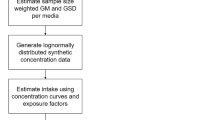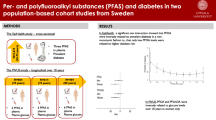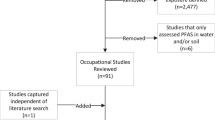Abstract
Background
Per- and polyfluoroalkyl substances (PFAS) are a growing class of manufactured chemical compounds found in a variety of consumer products. PFAS are ubiquitous in the environment and were found in many humans sampled in the United States (U.S.). Yet, significant gaps in understanding statewide levels of exposure to PFAS remain.
Objective
The goals of this study are to establish a baseline of exposure at the state level by measuring PFAS serum levels among a representative sample of Wisconsin residents and compare to United States National Health and Nutrition Examination Survey (NHANES).
Methods
The study sample included 605 adults (18+ years of age) selected from the 2014–2016 sample of the Survey of the Health of Wisconsin (SHOW). Thirty-eight PFAS serum concentrations were measured using high-pressure liquid chromatography coupled with tandem mass spectrometric detection (HPLC-MS/MS) and geometric means were presented. Weighted geometric mean serum values of eight PFAS analytes from SHOW were compared to U.S. national levels from the NHANES 2015–2016 sample (PFOS, PFOA, PFNA, PFHxS, PFHpS, PFDA, PFUnDA), and the 2017–2018 sample for Me-PFOSA, PFHPS using the Wilcoxon rank-sum test.
Results
PFOS, PFHxS, PFHpS, PFDA, PFNA, and PFOA were detected in over 96% of SHOW participants. In general, SHOW participants had lower serum levels across all PFAS when compared to NHANES. Serum levels increased with age and were higher among males and whites. Similar trends were seen in NHANES, except non-whites had higher PFAS levels at higher percentiles in NHANES.
Impact statement
The present study conducts biomonitoring of 38 PFAS among representative sample of residents in the state of Wisconsin. Results suggest that while the majority of Wisconsin residents tested have detectable levels of PFAS in their blood serum, they may have a lower body burden of some PFAS compared to a nationally representative sample. Older adults, males, and whites may have a higher body burden of PFAS relative to other groups, both in Wisconsin and the wider United States.
This is a preview of subscription content, access via your institution
Access options
Subscribe to this journal
Receive 6 print issues and online access
$259.00 per year
only $43.17 per issue
Buy this article
- Purchase on Springer Link
- Instant access to full article PDF
Prices may be subject to local taxes which are calculated during checkout

Similar content being viewed by others
Data availability
The datasets generated during and analyzed during the current study are not publicly available due to HIPAA protections for SHOW participants but may be available from the corresponding author on reasonable request with IRB approval.
References
Ghisi R, Vamerali T, Manzetti S. Accumulation of perfluorinated alkyl substances (PFAS) in agricultural plants: a review. Environ Res. 2019;169:326–41.
Sunderland EM, Hu XC, Dassuncao C, Tokranov AK, Wagner CC, Allen JG. A review of the pathways of human exposure to poly- and perfluoroalkyl substances (pfass) and present understanding of health effects. J Exposure Sci Environ Epidemiol. 2018;29:131–47.
Panieri E, Baralic K, Djukic-Cosic D, Buha Djordjevic A, Saso L. PFAS molecules: a major concern for the human health and the environment. Toxics. 2022;10:44.
Haukås M, Berger U, Hop H, Gulliksen B, Gabrielsen GW. Bioaccumulation of per- and polyfluorinated alkyl substances (PFAS) in selected species from the Barents Sea Food web. Environ Pollut. 2007;148:360–71.
Per- and polyfluorinated substances (PFAS) factsheet [Internet]. Centers for Disease Control and Prevention. Centers for Disease Control and Prevention; 2022. Available from: https://www.cdc.gov/biomonitoring/PFAS_FactSheet.html.
Hu XC, Andrews DQ, Lindstrom AB, Bruton TA, Schaider LA, Grandjean P, et al. Detection of poly- and perfluoroalkyl substances (pfass) in U.S. drinking water linked to industrial sites, military fire training areas, and wastewater treatment plants. Environ Sci Technol Lett. 2016;3:344–50.
Faithfull NS, Weers JG. Perfluorocarbon compounds. Vox Sanguinis. 1998;74:243–8.
Sinclair GM, Long SM, Jones OAH. What are the effects of PFAS exposure at environmentally relevant concentrations? Chemosphere 2020;258:127340.
Fenton SE, Ducatman A, Boobis A, DeWitt JC, Lau C, Ng C, et al. Per‐ and polyfluoroalkyl substance toxicity and human health review: current state of knowledge and strategies for informing future research. Environ Toxicol Chem. 2020;40:606–30.
Kurwadkar S, Dane J, Kanel SR, Nadagouda MN, Cawdrey RW, Ambade B, et al. Per- and polyfluoroalkyl substances in water and wastewater: a critical review of their global occurrence and distribution. Sci Total Environ. 2022;809:151003.
DeWitt JC. Toxicological effects of perfluoroalkyl and polyfluoroalkyl substances. Cham, New York: Springer International Publishing; 2015.
Nelson JW, Hatch EE, Webster TF. Exposure to polyfluoroalkyl chemicals and cholesterol, body weight, and insulin resistance in the general U.S. population. Environ Health Perspect. 2010;118:197–202.
Bassler J, Ducatman A, Elliott M, Wen S, Wahlang B, Barnett J, et al. Environmental perfluoroalkyl acid exposures are associated with liver disease characterized by apoptosis and altered serum adipocytokines. Environ Pollut. 2019;247:1055–63.
Wikström S, Lin P-I, Lindh CH, Shu H, Bornehag C-G. Maternal serum levels of perfluoroalkyl substances in early pregnancy and offspring birth weight. Pediatr Res. 2019;87:1093–9.
von Holst H, Nayak P, Dembek Z, Buehler S, Echeverria D, Fallacara D, et al. Perfluoroalkyl substances exposure and immunity, allergic response, infection, and asthma in children: review of epidemiologic studies. Heliyon. 2021;7:e08160.
Borghese MM, Walker M, Helewa ME, Fraser WD, Arbuckle TE. Association of perfluoroalkyl substances with gestational hypertension and preeclampsia in the MIREC study. Environ Int. 2020;141:105789.
Granum B, Haug LS, Namork E, Stølevik SB, Thomsen C, Aaberge IS, et al. Pre-natal exposure to perfluoroalkyl substances may be associated with altered vaccine antibody levels and immune-related health outcomes in early childhood. J Immunotoxicol. 2013;10:373–9.
Brennan NM, Evans AT, Fritz MK, Peak SA, von Holst HE. Trends in the regulation of per- and polyfluoroalkyl substances (PFAS): a scoping review. Int J Environ Res Public Health. 2021;18:10900.
Chen J, Tang L, Chen W-Q, Peaslee GF, Jiang D. Flows, stock, and emissions of poly- and perfluoroalkyl substances in California carpet in 2000–2030 under different scenarios. Environ Sci Technol. 2020;54:6908–18.
Podder A, Sadmani AHMA, Reinhart D, Chang N-B, Goel R. Per and poly-fluoroalkyl substances (PFAS) as a contaminant of emerging concern in Surface Water: a transboundary review of their occurrences and toxicity effects. J Hazard Mater. 2021;419:126361.
US EPA. Lifetime Drinking Water Health Advisories for Four Perfluoroalkyl Substances. 2022; 87 FRL 9855–01–OW. (To be codified and 87 C.F.R. pts. 36848, 36849).
Kidd J, Fabricatore E, Jackson D. Current and future federal and state sampling guidance for per- and polyfluoroalkyl substances in environmental matrices. Sci Total Environ. 2022;836:155523.
Chang CJ, Ryan PB, Smarr MM, Kannan K, Panuwet P, Dunlop A, et al. Serum per-and polyfluoroalkyl substance (PFAS) concentrations and predictors of exposure among pregnant African American women in the Atlanta area, Georgia. Environ Res. 2021;157:106843. Available from: https://www.sciencedirect.com/science/article/pii/S0160412021004682?via%3Dihub.
Birnbaum LS, Grandjean P. Alternatives to pfass: perspectives on the science. Environ Health Perspect. 2015;123:A104–5.
Aylward LL, Seiber JN, Hays SM. California biomonitoring data: comparison to NHANES and interpretation in a risk assessment context. Regulatory Toxicol Pharmacol. 2015;73:875–84.
Graber JM, Alexander C, Laumbach RJ, Black K, Strickland PO, Georgopoulos PG, et al. Per and polyfluoroalkyl substances (PFAS) blood levels after contamination of a community water supply and comparison with 2013–2014 NHANES. J Exposure Sci Environ Epidemiol. 2018;29:172–82.
Graber JM, Black TM, Shah NN, Caban-Martinez AJ, Lu SE, Brancard T, et al. Prevalence and predictors of per- and polyfluoroalkyl substances (PFAS) serum levels among members of a suburban US volunteer fire department. Int J Environ Res Public Health. 2021;18:3730.
Petriello MC, Mottaleb MA, Serio TC, Balyan B, Cave MC, Pavuk M, et al. Serum concentrations of legacy and emerging per- and polyfluoroalkyl substances in the Anniston Community Health Surveys (ACHS I and ACHS II). Environ Int. 2022;158:106907.
Yu CH, Weisel CP, Alimokhtari S, Georgopoulos PG, Fan ZT. Biomonitoring: a tool to assess PFNA body burdens and evaluate the effectiveness of drinking water intervention for communities in New Jersey. Int J Hyg Environ Health. 2021;235:113757.
Multiple state agencies responding to PFAS contamination on French Island [Internet]. Wisconsin Department of Natural Resources. Wisconsin Department of Natural Resources; 2021. Available from: https://dnr.wisconsin.gov/newsroom/release/42441.
Pfas contamination in the Marinette and Peshtigo Area [Internet]. PFAS Contamination in the Marinette and Peshtigo Area | | Wisconsin DNR. Wisconsin Department of Natural Resources; 2022. Available from: https://dnr.wisconsin.gov/topic/PFAS/Marinette.html.
Jha G, Kankarla V, McLennon E, Pal S, Sihi D, Dari B, et al. Per- and polyfluoroalkyl substances (PFAS) in integrated crop–livestock systems: environmental exposure and human health risks. Int J Environ Res Public Health. 2021;18:12550.
Johnson GR. Pfas in soil and groundwater following historical land application of Biosolids. Water Res. 2022;211:118035.
Water utility [Internet]. City of Madison, Wisconsin. Available from: https://www.cityofmadison.com/water/water-quality/water-quality-testing/perfluorinated-compounds.
Staff AC. Wisconsin population increased 3.6% since 2010 [Internet]. Census.gov. United States Census Bureau; 2021. Available from: https://www.census.gov/library/stories/state-by-state/wisconsin-population-change-between-census-decade.html.
Malecki KM, Nikodemova M, Schultz AA, LeCaire TJ, Bersch AJ, Cadmus-Bertram L, et al. The survey of the Health of Wisconsin (show) program: an infrastructure for advancing population health. Front Public Health. 2022;10:818777.
Minnesota Dept. of Public Health, Public Health Laboratory Division. Document DOC-563, Detection of PFAS in serum and Plasma via LC-MS/MS. Unpublished methods.
Centers for Disease Control & Prevention, National Center for Environmental Health. Laboratory Procedure manual NHANES 2015-16, method 6304.08. Perfluoroalkyl and Polyfluoroalkyl Substances.
New York State Dept. of Health, Division of Environmental Health Sciences, Laboratory of Organic Analytical Chemistry. Analysis of Perfluoroalkyl Substances In Human Serum by Solid Phase Extraction and Ultra High Performance Liquid Chromatography Tandem Mass Spectrometry. Unpublished methods.
Michigan Dept. of Community Health, Bureau of Laboratories. Document AC-54. Analysis of serum for PFAS by RP-HPLC-MRM-MS/MS. 2018. Unpublished methods.
Centers for Disease Control and Prevention. Nhanes - about the National Health and Nutrition Examination Survey. 2017. https://www.cdc.gov/nchs/nhanes/about_nhanes.htm (accessed 2 May 2022).
Prior HHS Poverty Guidelines and Federal Register references [Internet]. ASPE. 2022. Available from: https://aspe.hhs.gov/topics/poverty-economic-mobility/poverty-guidelines/prior-hhs-poverty-guidelines-federal-register-references.
Yu CH, Riker CD, Lu SE, Fan ZT. Biomonitoring of emerging contaminants, perfluoroalkyl and polyfluoroalkyl substances (PFAS), in New Jersey Adults in 2016–2018. Int J Hyg Environ Health. 2020;223:34–44.
Brunn H, Arnold G, Körner W, Rippen G, Steinhäuser KG, Valentin I. PFAS: forever chemicals—persistent, bioaccumulative and mobile. Reviewing the status and the need for their phase out and remediation of contaminated sites. Environ Sci Eur. 2023;35:1–50.
Yao Y, Burgess J, Volchek K, Brown C. Short-Chain PFAS Their Sources, Properties, Toxicity, Environmental Fate, and Treatment. In: Kempisty D, Xing Y, Racz L, editors. Perfluoroalkyl Substances in the Environment Theory, Practice, and Innovation [Internet]. Boca Raton: CRC Press; 2018. p. 447–67. Available from: https://www.taylorfrancis.com/chapters/edit/10.1201/9780429487125-20/short-chain-pfas-yuan-yao-justin-burgess-konstantin-volchek-carl-brown?context=ubx&refId=afa9c083-21ea-4dae-9c6e-4050e54eb255.
Nair AS, Ma ZQ, Watkins SM, Wood SS. Demographic and exposure characteristics as predictors of serum per- and polyfluoroalkyl substances (pfass) levels – a community-level biomonitoring project in Pennsylvania. Int J Hyg Environ Health. 2021;231:113631.
Sagiv SK, Rifas-Shiman SL, Webster TF, Mora AM, Harris MH, Calafat AM, et al. Sociodemographic and perinatal predictors of early pregnancy per- and polyfluoroalkyl substance (PFAS) concentrations. Environ Sci Technol. 2015;49:11849–58.
Wattigney WA, Savadatti SS, Liu M, Pavuk M, Lewis-Michl E, Kannan K, et al. Biomonitoring of per- and polyfluoroalkyl substances in minority angler communities in Central New York State. Environ Res. 2022;204:112309.
Olsen GW, Mair DC, Lange CC, Harrington LM, Church TR, Goldberg CL, et al. Per- and polyfluoroalkyl substances (PFAS) in American Red Cross Adult Blood Donors, 2000–2015. Environ Res. 2017;157:87–95.
Ding N, Harlow SD, Batterman S, Mukherjee B, Park SK. Longitudinal trends in perfluoroalkyl and polyfluoroalkyl substances among multiethnic midlife women from 1999 to 2011: The study of women′s health across the nation. Environ Int. 2020;135:105381.
DeLuca, NM, Thomas, K, Mullikin, A, Slover, R, Stanek, LW, Pilant, AN, et al. Geographic and demographic variability in serum PFAS concentrations for pregnant women in the United States. J Exp Sci Environ Epidemiol. 2023:1–15. PMID: 36697764 https://doi.org/10.1038/s41370-023-00520-6.
Chang CJ, Ryan PB, Smarr MM, Kannan K, Panuwet P, Dunlop AL, et al. Serum per-and polyfluoroalkyl substance (PFAS) concentrations and predictors of exposure among pregnant African American women in the Atlanta area, Georgia. Environ Res. 2021;198:110445.
Evans GW, Kantrowitz E. Socioeconomic status and health: The potential role of environmental risk exposure. Annu Rev Public Health. 2002;23:303–31.
Acknowledgements
The authors would like to thank all the SHOW investigators who made this work possible, WSLH staff who contributed to the creation of this data, and the SHOW participants. Special acknowledgement to the WSLH, NS for conceptualization and BS for sample analysis.
Funding
Funding for SHOW comes from the Wisconsin Division of Public Health, the Wisconsin Partnership Program (PERC) Award (223 PRJ 25DJ), the National Institutes of Health’s Clinical and Translational Science Award (5UL 1RR025011), and the National Heart Lunch and Blood Institute (1 RC2 HL101468) and a core grant to the Center for Demography and Ecology at the University of Wisconsin-Madison (P2C HD047873). Additional funding for this analysis came from the Association of Public Health Laboratories (APHL).
Author information
Authors and Affiliations
Contributions
Conceptualization: NS, BS, AAS, KCM. Methodology: NS, BS, ML, AAS. Sample analysis: BS, NS, ML. Data analysis: AAS, RP. Draft preparation: AAS, RP, NS, KCM. Review and Editing: AAS, RP, RI, JM, KCM. Supervision: KCM, NS. Funding acquisition: AAS, NS.
Corresponding author
Ethics declarations
Competing interests
The authors declare no competing interests.
Ethical approval
The SHOW protocol and informed consent documents are approved by the Health Sciences Institutional Review Board of the University of Wisconsin-Madison. Participants in SHOW gave consent to their information being used for research prior to this study.
Additional information
Publisher’s note Springer Nature remains neutral with regard to jurisdictional claims in published maps and institutional affiliations.
Rights and permissions
About this article
Cite this article
Schultz, A.A., Stanton, N., Shelton, B. et al. Biomonitoring of perfluoroalkyl and polyfluoroalkyl substances (PFAS) from the Survey of the Health of Wisconsin (SHOW) 2014–2016 and comparison with the National Health and Nutrition Examination Survey (NHANES). J Expo Sci Environ Epidemiol 33, 766–777 (2023). https://doi.org/10.1038/s41370-023-00593-3
Received:
Revised:
Accepted:
Published:
Issue Date:
DOI: https://doi.org/10.1038/s41370-023-00593-3



